The history of the WWII German Dress Bayonet -
The Third Reich produced a large number of edge weapons for all types of organizations. The military forces were issued daggers, swords and bayonets. Some of the non-military groups only received dress daggers as a symbol of status.
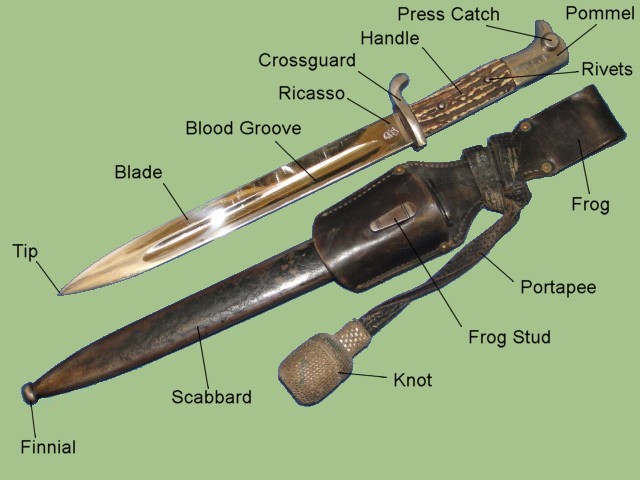
|
The guide was the opening located in the pommel and handle sections which coupled with the bayonet stud of the rifle
for the purpose of securing the bayonet to the rifle.
Because the dress bayonets were not intended for combat use, the guide was not found in all of the samples. Even
when the guide was present most of the time it was not functional.
|
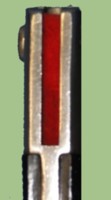 |
For the dress bayonets that retained the guide, different color felt inserts were placed in the guide itself.
|
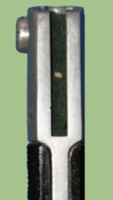 |
The dress bayonet could have been purchased in a variety of models. The soldier of civil servant had the ability to
select among the choices based on the amount of money he or she wanted to spend. Like anything else in life, the
fancier the handle the more money it cost.
Two rivets are used to secure the grips to the handle. The size and shape of the rivets varies greatly
depending on the model. Some of them are simple while others have characteristics such as a dome head.
The above photos also provide a glimpse of the different variations of pommels that can be found with dress
bayonets. Notice that some of the pommels do not have a press catch. That is because these examples do not
have the mechanism to attach to a rifle.
BAYONET POMMEL
Most of the pommels have the shape known as "bird head" because of its ressemblance to the the profile of a
bird. The more elaborate daggers exploited this similarity to the next level. Specially in the case of the
police bayonet. the designers went to the extent of adding plumeage and a line to simulate the ability for
the head to open its mouth. The press catch acted as the eye in the head.


|
BAYONET BLADES
Most of the blades for the bayonets were chromed and did not have any designs in them. However, as in many
other cases with German edge weapons, the person could enhance the appearance of the blade by adding engravings.
The engravings usually depicted scenes of military might. Tanks and aircrafts were commonly found as part of
the design. Additional components included eagles and mottos.
|
The bayonet manufacturer's catalogs present a wealth of information because it shows the different mottifs
that were applied to the blade. These catalogs were marketing tools designed to entice the person to add
more options to the bayonet, which directly translated to higer sales for the company.
DRDESS BAYONET TYPES
The following is a list of the most common types of dress bayonets:
ARMED FORCES DRESS BAYONET
The German armed forces were allowed a dress bayonet in addition to the regular dagger. Known as the model 98. This
sidearm was worn with the regular uniform. Distinguished by its curved-up single arm cross guard. The blade came
in two lengths, short (20 cms) and long (25 cms). The short bayonet was issued to NCO personnel. The long
bayonet was worn by enlisted men.
Of black plastic grips with a tightly designed checkered pattern. The grips are held together via the use of two
rivets. A Black leather frog was issued to Army personnel. Brown color for Luftwaffe and white color for SS or
parade. The grips could be ordered in stag horn.

FIRE DRESS BAYONET
Every state in Germany was responsible for providing its own fire proetction. The fire departments were composed of
a few paid employees supported by a fairly large volunteer force. When Hitler came to power he decided that the
various fire departments needed to be integrated for better control. Another step taken by Hitler was to infiltarte
Nazi party loyalist into the fire department. A move that included making it a part of the police department.
The fire department had a few different edge weapons. The most common was the junior subordinate dress bayonet.
Distinguished by its curved double arm cross guard. With a black plastiuc handle bearing a tight checkered
pattern. The grips are secured via the use of two silver rivets.
 POLICE DRESS BAYONET
POLICE DRESS BAYONET
The German police force was allowed to wear a bayonet sidearm during the Weimar Republic. The designed was based on
the model 98/05 bayonet. However, several modifications were implemented before issuing the new edge weapon to the
police. Among the modifications are the blade was shortened, the width was reduced and was nickel plated.
Perhaps the handle underwent the most serious changes. The wood grips were replaced by stag handles. They remained
held together by two rivets. A metal police eagle logo was placed at the center of one of the grips. The pommel also
experienced drastic changes, gone was the simple plain pommel which was replaced by an eagle's head complete with
plumeage.

| GERMAN ARMY DRESS BAYONET EXAMPLES |
The more examples of a particular dagger that are examined the more knowledge is gained about the particular piece.
Differences in construction can be better appreciated. Markings on the blade and other sections are better understood.
The overall knowledge about the dagger is expanded.
This section of the site provides several examples of the army dress bayonets.
| GERMAN BAYONET MANUFACTURERS |
The following is a list of some of the companies that manufactured the dress bayonet during WWII.
It is important to note that this may not be a complete list as it is possible that
others manufacturers exist.
| Count |
Unique Makers |
Company |
Description |
Logo |
Comments |
| 1 |
1 |
WKC |
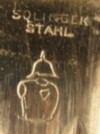 |
Armored chest and spiked helmet. Name of town above. |
n/a |
| 2 |
|
WKC |
 |
Upper half of Knight armor facing left. |
Solingen - Stahl |
| 3 |
|
WKC |
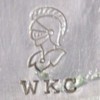 |
Upper half of Knight armor facing left. WKC written below. |
Solingen |
| 4 |
2 |
Tiger |
 |
"Tiger" written in capital letters. |
Solingen |
| 5 |
|
Tiger |
 |
Image of a tiger. no words. |
Solingen |
| 6 |
3 |
E. Pack & Sohne |
 |
Man swinging sledge hammer. name and city in front. |
Solingen |
| 7 |
|
E. Pack & Sohne |
 |
Man swinging sledge hammer. name and city in front. Name Sigfried in large font. |
Solingen |
| 8 |
4 |
Klittermann |
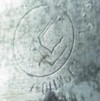 |
Bent arm with hand holding a hammer. Everything inside a circle. Name of company in bottom section. |
Solingen |
| 9 |
5 |
Gustav Spitzer |
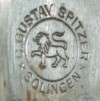 |
Prancing lion inside a circle. Name and city encircling perimeter. |
Solingen |
| 10 |
6 |
Eickhorn |
 |
Squirrell holding a sword. |
Solingen |
| 11 |
|
Carl Eickhorn |
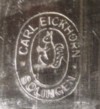 |
Squirrell inside double oval. |
Solingen |
| 12 |
7 |
Lauterjung |
 |
Text written in upper case. |
Duisaug |
This information is brought to you courtesy of
MilitaryItems.com.
The premiere provider of military collectibles to musuems, educational institutions and the general enthusiast.
|







